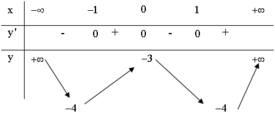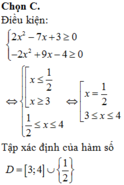Tinh A=2/3. X2Y(2X2-Y/3)-2X2(2X2+1)+(2X2-Y/3)(1-Y/3)(2X2-1)
Hãy nhập câu hỏi của bạn vào đây, nếu là tài khoản VIP, bạn sẽ được ưu tiên trả lời.


\(1,\\ a,A=4x^2\left(-3x^2+1\right)+6x^2\left(2x^2-1\right)+x^2\\ A=-12x^4+4x^2+12x^2-6x^2+x^2=-x^2=-\left(-1\right)^2=-1\\ b,B=x^2\left(-2y^3-2y^2+1\right)-2y^2\left(x^2y+x^2\right)\\ B=-2x^2y^3-2x^2y^2+x^2-2x^2y^3-2x^2y^2\\ B=-4x^2y^3-4x^2y^2+x^2\\ B=-4\left(0,5\right)^2\left(-\dfrac{1}{2}\right)^3-4\left(0,5\right)^2\left(-\dfrac{1}{2}\right)^2+\left(0,5\right)^2\\ B=\dfrac{1}{8}-\dfrac{1}{4}+\dfrac{1}{4}=\dfrac{1}{8}\)
\(2,\\ a,\Leftrightarrow10x-16-12x+15=12x-16+11\\ \Leftrightarrow-14x=-4\\ \Leftrightarrow x=\dfrac{2}{7}\\ b,\Leftrightarrow12x^2-4x^3+3x^3-12x^2=8\\ \Leftrightarrow-x^3=8=-2^3\\ \Leftrightarrow x=2\\ c,\Leftrightarrow4x^2\left(4x-2\right)-x^3+8x^2=15\\ \Leftrightarrow16x^3-8x^2-x^3+8x^2=15\\ \Leftrightarrow15x^3=15\\ \Leftrightarrow x^3=1\Leftrightarrow x=1\)

Đáp án C
Đáp án: Hàm số y = x 2 − 2 x − 3 không có đạo hàm tại x = 0
Hàm số y = x 2 − 1 − 4 không có đạo hàm tại x = ± 1. Hàm số y = − x 4 + 2 x 2 − 3 có lim x → ± ∞ = − ∞
Nên bảng biến thiên trên không là bảng biến thiên của 3 hàm số trên. y = x 4 − 2 x 2 − 3
Kiểm tra ta có đó là bảng biến thiên của hàm số: y = x 4 − 2 x 2 − 3

`Answer:`
a. Thay `x=2` và `y=9` vào biểu thức `A`, ta được:
\(A=2.2^2-\frac{1}{3}.9=2.4-\frac{1}{3}.9=8-3=5\)
b. Thay `x=-1/2` và `y=2/3` vào biểu thức `P`, ta được:
\(P=2.\left(-\frac{1}{2}\right)^2+3.\left(-\frac{1}{2}\right).\left(\frac{2}{3}\right)+\left(\frac{2}{3}\right)^2=2.\frac{1}{4}+3.\left(-\frac{1}{2}\right).\left(\frac{2}{3}\right)+\frac{4}{9}=\frac{1}{2}+\left(-1\right)+\frac{4}{9}=-\frac{1}{18}\)

a. 3xy( 4x + y - \(\dfrac{4}{3}\) )
b. 2x2( 3x + 1 )
c. (2x + 3 )( x - y )
d. xy( 1 - x )( x - 1 )
e. 6( 2x + 1 )( x + y )

\(VT=\dfrac{2x^2+2xy+xy+y^2}{x^2\left(2x+y\right)-y^2\left(2x+y\right)}=\dfrac{2x\left(x+y\right)+y\left(x+y\right)}{\left(x^2-y^2\right)\left(2x+y\right)}\\ =\dfrac{\left(2x+y\right)\left(x+y\right)}{\left(2x+y\right)\left(x-y\right)\left(x+y\right)}=\dfrac{1}{x-y}=VP\)



